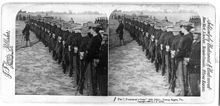Camp Alger
The camp was abandoned in early August 1898, by which time the number of troops there had risen to more than 35,000, following a Typhoid outbreak and the War Department put it up for sale in September.
Immediately after the selection of this camp preparations were made for the reception of troops by the erection of storehouses at Dunn Loring, where the Southern Railway put in extra sidings to accommodate the increased traffic.
[8] Another unit from McKinley's home state was the Ninth Ohio Volunteer Infantry Battalion, an African American regiment.
[9] When President William McKinley and his Cabinet visited Camp Alger, on May 28, 1898,[10][11] two short films were made of this event.
[1] The woods were quite badly polluted by the excreta of the men; but the commanding officer issued stringent sanitary regulations and used great efforts to see that they were obeyed.
Field bakeries were established in the camp and at Dunn Loring on August 2, from which the corps was supplied with excellent bread.
The establishment of Camp Alger is justifiable upon the report as to the suitableness of the site, but considering the scarcity of water and the want of facilities for bathing, we are of opinion that it was very undesirable, and was not abandoned too soon.
"[1] On August 2 the 2nd Division of the corps marched to Thoroughfare Gap, 30 miles distant, and remained in camp there for about one month.
In 1907 the War Department considered buying it back to create a rifle range, but chose a location in Petersburg, Virginia instead.
(U.S. 50) near Fenwick St. in Falls Church, near the spot where the Corps Headquarters was and the other on Sandburg Street in Dunn Lorring near the rail depot.

